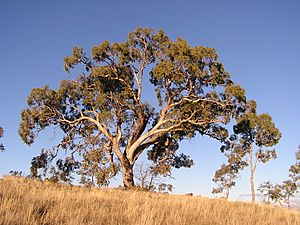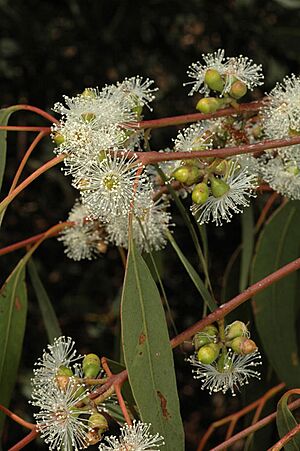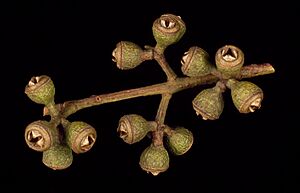Apple gum facts for kids
Quick facts for kids Apple box |
|
|---|---|
 |
|
| Eucalyptus bridgesiana in the Australian Capital Territory | |
| Conservation status | |
| Scientific classification | |
| Genus: |
Eucalyptus
|
| Species: |
bridgesiana
|
The Apple Box (scientific name: Eucalyptus bridgesiana) is a medium to large tree found in Australia. It's also known by other names like apple, apple gum, or but-but. This tree has rough bark on its trunk and big branches, but smooth grey bark higher up. It has shiny green leaves, white flowers that grow in groups, and round, woody fruits.
Contents
What Does the Apple Box Look Like?
The Apple Box tree usually grows to be about 20 to 25 metres (66 to 82 ft) tall. That's as tall as a six or seven-story building! It has a special woody swelling at its base called a lignotuber. This helps the tree regrow if there's a fire or damage.
Bark and Leaves
The bark on the main trunk and larger branches is rough and feels like fiber. It's a mix of grey and white, sometimes looking like a puzzle with many small pieces. The thinner branches have smooth, grey bark that peels off in short strips, showing whitish patches underneath.
When the tree is young, or if new shoots grow from the base, the leaves are different. They are egg-shaped or heart-shaped, about 25–100 mm (0.98–3.9 in) long and 20–80 mm (0.8–3 in) wide. These young leaves are arranged in pairs and have wavy edges. They often look like they're covered in a powdery white dust.
As the tree gets older, the leaves change. Adult leaves are long and narrow, like a spearhead. They are shiny green on both sides, about 120–200 mm (4.7–7.9 in) long and 15–25 mm (0.6–1 in) wide. Each leaf has a stem called a petiole that is about 12–35 mm (0.47–1.4 in) long.
Flowers and Fruit
The Apple Box tree's flower buds grow in groups of seven. These groups are on a small stalk called a peduncle, which can be up to 15 mm (0.6 in) long. Each individual bud has its own tiny stem, about 1–5 mm (0.04–0.2 in) long.
The mature buds are usually oval-shaped, about 5–8 mm (0.20–0.31 in) long and 3–5 mm (0.1–0.2 in) wide. They have a cap-like top that can be cone-shaped or look like a beak. The tree blooms from February to March, and its flowers are white.
After flowering, the tree produces fruit. The fruit is a woody, half-sphere shaped capsule. It's about 3–7 mm (0.12–0.28 in) long and 4–8 mm (0.16–0.31 in) wide. When the fruit opens, three parts (called valves) stick out above the rim.
How the Apple Box Got Its Name
The scientific name for the Apple Box is Eucalyptus bridgesiana. It was first officially described in 1898 by a botanist named Richard Thomas Baker. He published his description in a scientific journal called Proceedings of the Linnean Society of New South Wales.
The second part of its name, bridgesiana, was chosen to honor Frederick Bridges (1840-1904). He was recognized for helping to apply scientific knowledge to Australia's native plants.
Where Does the Apple Box Grow?
The Apple Box tree likes to grow in open woodlands and forests. You can find it in many places across eastern Australia. It grows from near Stanthorpe in Queensland, south through the hills and mountain ranges of New South Wales, and into eastern Victoria.
An interesting fact is that the Sydney suburb of Tallawong, New South Wales is named after the Dharug word for the Apple Box tree.
Uses of the Apple Box Tree
The wood from the Apple Box tree is softer than the wood from many other types of eucalypt trees. Because of this, it's not considered very good for firewood or for building things.
However, the small white flowers of the Apple Box are very important for bees! Bees collect nectar from these flowers to make honey. The honey produced from Apple Box flowers is known to be of very high quality.




